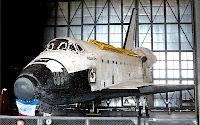Up early and ready to go visit The Kennedy Space Center. Patti spent her elementary school period wanting to be an astronaut, so this was a real highlight for her-actually for both of us. We each have a memory of when they landed on the moon the summer of 1969, watching the landing on TV and then going outside and looking at the full moon knowing that there were people up there. We wanted to see where that journey started.
We were the first people through the turnstile ready to soak
in as much as we could. We took advantage
of a quick guided tour through the “Rocket Garden.” These were real rockets, which were available
because they had not been used. They were huge even larger than we had
imagined.
The highlight of the morning was a special guided tour NASA Close-up:
Today and Tomorrow. This two-hour,
behind the scenes tour took us throughout Cape Canaveral and The Kennedy Space
Center (which we learned were two distinctly different areas). We saw the launch pads that were used for all
of the Apollo and shuttle launches and will be used for the next generation of
rocket launches. This was very exciting.
And we also got to go inside of the Vehicle Assembly Building, a mammoth structure where the rockets that
took men to the moon and space shuttles were stacked and assembled before
launch. This building had been off
limits to the public for the last 30 years while the space shuttle was active,
but now is part of the special tour. It
is a big building!!!
We even got to see the space shuttle, Atlantis, getting ready for its new home at the Kennedy Space Center Visitor’s’ Center next summer. It looked magnificent, and as though it had been through a lot.
We even got to see the space shuttle, Atlantis, getting ready for its new home at the Kennedy Space Center Visitor’s’ Center next summer. It looked magnificent, and as though it had been through a lot.
At the Vehicle Assembly Building, we had a guest speaker who
was part of the crew that prepared the heat protection for the space shuttles. An interesting fact was, much of the space
shuttle protection had to be sewn, and sometimes even hand sewn. This woman was
an experienced quilter before she got the job. Who would have thought of this? She was fascinating. She passed around some
of the materials and fabric they used to protect the shuttles. It was amazingly lightweight. She also showed us how all of the crew who
worked on a shuttle signed a banner of encouragement which the astronauts could
see as they were getting ready to launch.
We also had the chance to walk under and around one of the
huge rockets that launched the Apollo missions, a Saturn V. You couldn't even really take the photo; they
are as tall as a 36-story building.
And we got the touch a piece of rock that came from the
moon! Beautiful black stone. Kind of magical, although Dick thought it
felt just like an ordinary piece of slate, but it had come from the moon!
The museum parts of the displays were filled with lunar modules,
actual space suits, real moon boots, and lots of other cool equipment and
artifacts.
One of the fascinating things that we learned was that the
entire land that NASA owns, which is huge, is also a National Wildlife Refuge
and the animals are all protected including lots of American Bald Eagles, manatees,
sea turtles, and 340 types of birds, as well as lots and lots of alligators. What a good double use of the land. We got to see a gigantic eagle’s nest, the
top of which was as a large as a queen-sized bed, and several alligators swimming
in the water beside our bus.
The only sad thing was to have to leave before we had the
sense that we had seen everything. This
was truly something you could do for two full days, and we had only 4
hours. That is the disadvantage of all
we are fitting into this trip. This is
not the “in-depth look” at anything…. more like the survey course through 1200
years of history in a month.
Shifting gears, from space and traveling beyond the Earth to
St. Augustine FL, the place of the earliest European landing and settlement in
what would become American. One might
ask, who designed this combination of things to see and study? It was Patti and Dick, and we have a greater
than average range of interests, but some days it is a bit dizzying shifting
between such different topics.










No comments:
Post a Comment